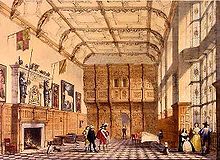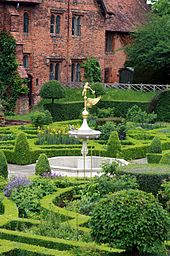Hatfield Palace
History

An earlier building on the site was the Royal Palace of Hatfield. Only part of this still exists a short distance from the present house. That palace was the childhood home and favourite residence of Queen Elizabeth I. Built in 1497 by the Archbishop of Canterbury (formerly Bishop of Ely), King Henry VII's minister, John Cardinal Morton, it comprised four wings in a square surrounding a central courtyard. The palace was seized by Henry VIII with other church properties. The nearby parish church of St Etheldreda's in Old Hatfield once served the bishop's palace as well as the village. Henry VIII's children, King Edward VI and the future Queen Elizabeth I, spent their youth at Hatfield Palace. His eldest daughter, who later reigned as Queen Mary I, lived there between 1533 and 1536, when she was sent to wait on the then Princess Elizabeth as punishment for refusing to recognise Henry's marriage to Anne Boleyn and his religious reforms. In 1548, when she was only 15 years old, Elizabeth was under suspicion of having illegally agreed to marry Thomas Seymour. The house and her servants were seized by Edward VI's agent, Robert Tyrwhit, and she was interrogated there. She successfully defended her conduct with wit and defiance. Seymour was executed in 1549 for numerous other crimes against the crown. After her two months of imprisonment in the Tower of London by her sister, Queen Mary, Elizabeth returned to Hatfield. The Queen Elizabeth Oak on the grounds of the estate is said to be the location where Elizabeth was told she was queen following Mary's death, but is considered unlikely as Mary died in November. In November 1558, Elizabeth held her first Council of State in the Great Hall.
Hatfield House is a popular tourist attraction because it has so many objects associated with Queen Elizabeth I, including gloves and a pair of silk stockings that are believed to have been the first in England. The library displays a 22-foot (6.7 m) long illuminated parchment roll showing the pedigree of the queen with ancestors back to Adam and Eve. The Marble Hall holds the "Rainbow Portrait" of Elizabeth.

Elizabeth's successor, King James I, did not like the palace. It was included in the jointure estate of his wife Anne of Denmark. In 1607, King James gave it to his chief minister, Robert Cecil, 1st Earl of Salisbury, in exchange for Theobalds, which was the Cecils' family home on the current site of Cedars Park, Broxbourne. Cecil, who liked building, tore down three wings of the royal palace (the back and sides of the square) in 1608 and used the bricks to build the present structure. The richly carved wooden Grand Staircase and the rare stained glass window in the private chapel are among the house's original Jacobean features. Cecil employed Robert Lemynge to supervise the construction, with input from the royal surveyor Simon Basil, and Inigo Jones who visited in October 1609.
During World War II, Hatfield House was the location of the first Civil Resettlement Unit and acted as headquarters for the scheme. CRUs were created to help repatriated British prisoners of war transition back to civilian life and the luxurious setting of Hatfield was considered very beneficial to these men. On 12 July 1945, the king and queen visited the CRU at Hatfield, which generated significant news coverage.
Gardens

The gardens, covering 42 acres (170,000 m), date from the early 17th century and were laid out by John Tradescant the elder. Tradescant visited Europe and brought back trees and plants that had never previously been grown in England. The gardens included orchards, fountains, scented plants, water parterres, terraces, herb gardens and a foot maze. They were neglected in the 18th century, but restoration began in Victorian times and continues under the present Dowager Marchioness of Salisbury.
During World War I, the grounds were used to test the first British tanks. An area was dug with trenches and craters and covered with barbed-wire to represent no man's land and German trench lines on the Western Front. To commemorate this, the only surviving Mark I tank was sited at Hatfield from 1919 to 1970 before being moved to The Tank Museum, Bovington.
The Rhodesian Light Infantry Regimental Association has placed its 'Troopie' memorial statue on the grounds of Hatfield House due to the long association of the Cecil family with Southern Rhodesia. Around its base is a roll of regimental members ('troopies') who fell in the Rhodesian Bush War and several inscriptions, including 'In reconciliation and hope for future peace in Zimbabwe'.
Tours
The State Rooms can be seen in the midweek guided tours and visitors can look around in their own time at weekends. On Friday, the Garden Connoisseur's Day, the house is open for guided tours and pre-booked specialist groups. There are five miles of marked trails.
Gallery
-
Hatfield House
-
The Long Gallery
-
The Armoury
-
Hatfield house, North wing
-
Hatfield House, Side view
Film credits
Hatfield House has been used for location filming on a number of film and television productions, including: Greystoke: The Legend of Tarzan, Lord of the Apes (1984); Orlando (1992); Batman (1989); Tomb Raider: Underworld, Lara Croft Tomb Raider: The Cradle of Life, Rise of the Tomb Raider and Shadow of the Tomb Raider; Charlie and the Chocolate Factory (2005); The New World (2005); Elizabeth: The Golden Age (2007); Hot Fuzz (2007); Shakespeare in Love (1998); Dustbin Baby; Sherlock Holmes (2009); Agatha Christie's Marple (2010); Get Him to the Greek (2010); Antiques Roadshow (2010); MasterChef Australia (2010); Garden Secrets (2010); Royal Upstairs Downstairs (2011); My Week with Marilyn (2010); Paddington (2014); Mr. Holmes (2015); Doctor Thorne; Pride and Prejudice and Zombies (2016); The Crown; Breathe (2017); All the Money in the World (2017); Trust;The Favourite (2018); "Sucker" (2019); Enola Holmes; Rebecca (2020); Bridgerton (2020); Cromwell; Henry VIII and His Six Wives; The Avengers (1998); V for Vendetta; Mortdecai (2015); and Paddington 2.
References
- ^ Historic England. "Hatfield House (1173363)". National Heritage List for England. Retrieved 11 August 2023.
- ^ Edmund Lodge, Illustrations of British History, vol. 3 (London, 1791), pp. 207.
- ^ Giles Worsley, Inigo Jones and the European Classical Tradition (Yale, 2007), p. 10.
- ^ White, Alice (2016). "Chapter Five: Settling down in Civvy Street". From the Science of Selection to Psychologising Civvy Street: The Tavistock Group, 1939-1948 (Thesis). University of Kent.
- ^ "The King and Queen with Ex-Prisoners: Visit to Civil Resettlement Unit". The Yorkshire Post and Leeds Mercury. 13 July 1945.
- ^ "Resettling War Prisoners: Aids to Civil Life: The King and Queen at Hatfield". The Times. 13 July 1945. CS69681389 – via Gale.
- ^ "Army's Civil Resettlement: King and Queen Visit Hatfield House Centre". The Manchester Guardian. 13 July 1945 – via Proquest.
- ^ "Hatfield House | Visit Hatfield House, Park & Gardens In Hertfordshire, UK". Hatfield House. Retrieved 5 November 2023.
- ^ "Identity Crisis". The Bovington Tank Museum. May 2006. Archived from the original on 12 February 2008. Retrieved 11 January 2008.
- ^ Troper Report Archived 27 May 2015 at the Wayback Machine
- ^ "Filming". Hatfield House. 2010. Archived from the original on 18 July 2011. Retrieved 4 October 2010.
- ^ Medd, James (18 November 2018). "Where was 'Hot Fuzz' filmed?". CN Traveller. Retrieved 31 January 2021.
- ^ "BBC One's Antiques Roadshow here this summer". Hatfield House. 5 May 2010. Archived from the original on 18 July 2011. Retrieved 4 October 2010.
- ^ Masterchef Australia, Television New Zealand website. Retrieved on 27 October 2011.
- ^ "Alan Tichmarsh's Garden Secrets". BBC. 8 November 2010. Archived from the original on 25 May 2024. Retrieved 8 November 2010.
- ^ "Filming Locations for Paddington (2014), around London". Movie Locations. The Worldwide Guide To Movie Locations. Retrieved 23 January 2021.
- ^ O'Connor, Joanne (5 December 2014). "On location: Paddington". Financial Times. Archived from the original on 10 December 2022.
- ^ Davies, Alan (19 June 2015). "Mr Holmes starring Sir Ian McKellen filmed in Hatfield". Welwyn Hatfield Times. Archived from the original on 29 October 2020. Retrieved 26 October 2020.
- ^ "13 Film Locations from the Crown (That Yes, You Can Visit IRL)".
- ^ "Breathe starring Claire Foy and Andrew Garfield filmed in Hatfield". 29 October 2017.
- ^ Malkin, Marc (2 April 2018). "Here's How FX's New Series Trust Replicated the Sutton Place Estate of John Paul Getty III". Architectural Digest. Retrieved 6 April 2018.
- ^ Hill, Erin (1 March 2019). "The Jonas Brothers' Music Video Has a Major Royal Connection – and It's Not Just the Corgi Cameo!". People. Retrieved 1 March 2019.
- ^ Andriotis, Mary Elizabeth (13 October 2020). "You Can Visit These English Estates from Netflix's 'Enola Holmes'". House Beautiful. Retrieved 26 October 2020.
- ^ Davies, Alan (26 September 2020). "Netflix movie Enola Holmes filmed at Hatfield House". Welwyn Hatfield Times. Archived from the original on 21 November 2020. Retrieved 26 October 2020.
- ^ Zemler, Emily (21 October 2020). "Where Netflix's 'Rebecca' found its Manderley". Los Angeles Times. Retrieved 25 October 2020.
- ^ Andriotis, Mary Elizabeth (22 October 2020). "You Can Visit These English Manor Houses from Netflix's Rebecca". House Beautiful. Retrieved 26 October 2020.
- ^ Davies, Alan (15 December 2020). "Bridgerton 'has something for everyone and that's why it's a special show'". Welwyn Hatfield Times. Retrieved 30 December 2020.
- ^ (executive producer & showrunner of Bridgerton) Chris Van Dusen [@chrisvandusen] (28 December 2020). "We searched and searched for the perfect garden maze to shoot this scene in. Found it at Hatfield House. #Bridgerton #LiveTweet https://t.co/z9rjkmt6Ac" (Tweet) – via Twitter.
Further reading
- Cecil, Lord David. The Cecils of Hatfield House: An English Ruling Family. Houghton Mifflin, 1973.
External links
- Official website
- A detailed historical record of Hatfield Palace
- Photos tagged Hatfield House at Flickr





